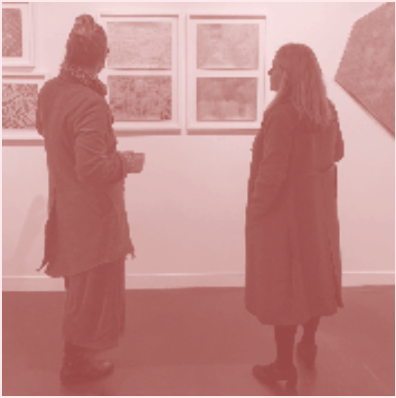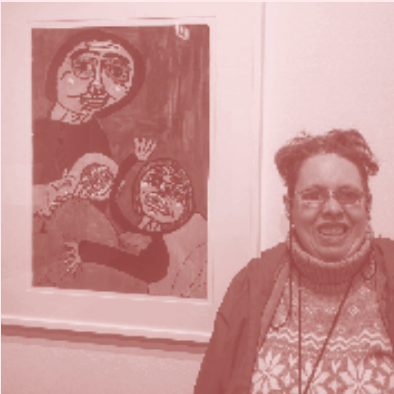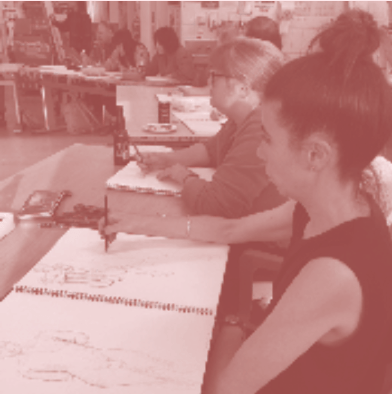The Art of Attentive Love—
Jacqueline Millner
Associate Professor of Visual Arts
at La Trobe University
and widely published writer on contemporary art
Feminist ethics pay attention to the particular rather than look to universals; they ground things in a contextual and narrative frame rather than seek to abstract them; they use a conversational mode for decision-making rather than defer to absolutist logic.1 Feminist care ethics understand the world as being in a state of relationship, where no part is isolated and autonomous, and where small and intimate acts are connected to a broader politics. FEM-aFFINITY embraces these feminist ethics of care as alternative to the conventional moral imperative based on the injunction to respect the ‘rights’ of individuals. The moral imperative of care, by contrast, is based on the notion of relationship, on nurturing, and a responsibility to ‘alleviate the “real and recognisable trouble” of this world’.2 According to feminist care ethics, what you do should be guided not by duty but by an exercise of moral imagination, by ‘attentive love’.

Attentive love, proposes British writer Iris Murdoch, is a moral reorientation that requires developing one’s powers of attention: it is this that allows us to see others’ realities and to constitute them as people with separate needs from our own, but also to recognise our needs in common. Murdoch argues that because it asks that we consider things outside of us intently and openly, attentive love is a discipline similar to that honed by artists.3 By bringing together artists’ predisposition to attention and a deep commitment to curating in relationship, FEM-aFFINITY redoubles on attentive love, creating opportunities for artists and audiences alike to access different realities through shared experience. That shared experience comes in part from all of the artists identifying as women and as artists, but it is also nurtured by the feminist curatorial approach that questions hierarchies of practice and acknowledges that voices and identities are shaped by interrelation and are always in the process of becoming. FEM-aFFINITY emerges from that interaction between artists from within and outside Arts Project Australia at an intimate one-on-one level – given the artists were introduced as pairs six months prior to allow them time to organically develop work in dialogue – as well as through co-working and co-exhibiting. FEM-aFFINITY emphasises the relational nature of the works as much as of the ideas and processes behind the exhibition.
The focused and productive energy of the Arts Project Australia studio – fuelled by acts of intense making and the companionship of working alongside one another as well as together – was key to inviting outside artists to loosen old habits and reflect on their own approaches. In particular, non-Arts Project artists could risk abandoning their more individualist and artworld-sensitive practices – defensive strategies that in a patriarchal world are exacerbated by internalised gender expectations. The supportive environment allowed for multiple exchanges and affirmed different forms of making, of discourse, and of professionalism, which cut across categories of neurotypicality and, instead, put the focus on process-based affinities.
Affinities are also foregrounded in the exhibition, which places the artworks and the artists in a complex matrix that refuses established curatorial and art historical categories and invites the audience to participate in processes of becoming. Maximising freewheeling and playful connections, FEM-aFFINITY is a riot of material and emotional interaction: it sparks moments of ‘unrestrained revelry’ that threaten to ‘disturb the peace’ and constitutes a ‘disorderly profusion’ that is often ‘wildly amusing’.4 The exhibition activates as many correspondences (or affinities) as possible, and not just between the collaborating artists. Works by each pair are installed adjacent to each other, but there are at least two contributions by each artist so that a sense of ongoing dialogue is created: a painting in the back space may ping back to a photograph in the front, and the conceptual and formal links are yet again reconfigured. That constant movement is helped along by the disparities in scale and medium throughout the show: intimate and informal life drawings or family snaps are interspersed with large-scale, slickly finished paintings; floor-to-ceiling prints are set off by tiny abstract doodles; works distinguished by their purity of line or colour punctuate performative photography. Each work reaches out to the others across time, space and medium, testament to the relationships between long-term studio neighbours and within newly formed creative partnerships, as well as to the generous and thoughtful facilitation by Arts Project Australia and curator Catherine Bell.

1. Margaret urban Walker, ‘Moral understandings: Alternative “Epistemology” for a Feminist Ethics’, in E. Cole and S. Coultrap-Mcquin (eds), Explorations in Feminist Ethics: Theory and Practice, Indiana university Press, Bloomington, 1992, p 166.
2. Carol Gilligan, In a Different Voice: Psychological Theory and Women’s Development, Harvard university Press, Cambridge, Mass., 1982, pp 159–60, cited in Susan Mendus, Feminism and Emotion: Readings in Moral and Political Philosophy, Macmillan, London, 2000, p 99.
3. Iris Murdoch, The Sovereignty of Good, Schocken, New York, 1971, pp 34, 66.
Prudence Flint and Cathy Staughton respond directly to each other’s work. Together, Cut on the Cross (Flint, 2013) and Catherine Bell Love Anne Baby Same (Staughton, 2019) unleash the repressed eroticism of the encounter between woman and dressmaker’s dummy. In Flint’s commanding and tightly composed Feed (2019), the breastfeeding mother appears determined and self-possessed, but alongside Staughton’s mother and child (A Man Doctor Cut Poor Facts Mother Help Me Out R2-D2 Robot Baby, 2008), the latent riotousness of the scene emerges. That latency is fully released in Flint’s fast and furious sketches of a couple in various erotic entanglements, a new series indebted to the sensual licence allowed by the dialogue between the two artists’ work.
An erotic charge sets alight and connects unlikely works throughout the exhibition. Lisa Reid’s portrait of collector Peter Fay (2007) – a longtime supporter of Australian contemporary artists, particularly those who don’t identify as insiders – captures the subject’s infectious enthusiasm in his gesturing hands and bright eyes, and effectively contrasts his conservative garb with his genuine love for the marginalised. But the portrait comes doubly alive by way of affinities with Reid’s life drawings and Yvette Coppersmith’s portrayals of a shirtless John Safran and a cool Mark Feary (John Safran, 2009, and Forever in Blue Jeans, 2007–08). In Reid’s striking pen and ink depictions of naked men of a certain age, detail of the striped fabric which drapes across the models’ bodies echoes in Fay’s preppy shirt, while vulnerable bellies find fleshy counterparts in Safran’s maladroit body. Such juxtapositions manage to invoke another portrait of Fay (not featured in the exhibition but present by association), namely Dani Marti’s video Bacon’s Dog (2010), which achingly documents Fay’s first sexual experience in late middle age.
Power in vulnerability – the resilience that comes from remaining open to others and the world – is also embodied in the cadavre exquis created by printmakers Heather Shimmen and Bronwyn Hack. The floor-to-ceiling work stitches together body fragments harvested from the artists’ shared love of true crime and Gothic imagery, creating a monstrous feminine coursing with sexuality and laughter. The monstrous feminine as reflective of a kind of alternative ethics, not grounded in anthropocentrism, is echoed in the animal-woman hybrids of Dorothy Berry and Jill Orr. Orr’s performance Lunch with the Birds (1979) – one of the few historical works in the exhibition, and part of the only pairing where the artists’ collaboration did not entail real-time interaction – is documented like a series of horror film stills, Gothic skies included. The photographs depict the artist beseeching the seagulls at St Kilda Beach, her body a splayed offering of loaves and fishes. Adjacent hangs a painting of a bird-woman by Berry (Not titled, 2009), whose use of bird motifs over many decades, curators suggest, amounts to a self-portrait.5 While the gulls ignored Orr’s invitation for inter-species communion, Berry appears to inhabit the bird, a feat Orr got closer to in Antipodean Epic – Interloper (2016).
This animus continues in the intimate scale and restrained palette of Jane Trengove’s and Fulli Andrinopoulos’s minimal forms, the intensity derived from the repetition of infinite nuance rather than through transgressive bodies and overt sexuality. The works were created in dialogue – one can imagine the meditative trance of a silent collective practice – but continue their interaction in the gallery: Trengove’s glowing spheres hover between two and three dimensions, between pure light and solid mass, their near- perfection brought back to earth by Andrinopoulos’s texturally expressive and rapid experiments. A similar exchange of energy animates the collaboration between Helga Groves and Wendy Dawson. Groves’ intricate abstract paintings, in part inspired by natural geological formations and patterns, both stimulated and responded to Dawson’s concentrated mark- making, each artist taking mutual creative cues to move their works into rhythmic synch – embodying the essence of becoming in relation to another.
The creative momentum that comes from sharing processes and spaces for making also drives the works of photomedia artists Eden Menta and Janelle Low, whose artistic partnership has grown into a personal friendship. That rapport is evident in the glimpses of shared intimate moments (Eden in the Mirror, 2019) alongside photographic explorations of identity and sexuality (such as Low’s Untitled (self-portrait), 2013, and her poignant series of family portraits where the faces are blotted out with gold leaf). The freedom and outrageousness allowed by being grounded in the trust of another and in a common set of values is perhaps best captured in the glorious Eden and the Gorge (2019). In this jointly authored photograph, Menta throws back her head and lifts her skirt to the Australian landscape in a gesture of joy and defiance. It brings to mind feminist activist Audre Lorde’s notion of ‘the erotic as power’:
The sharing of joy, whether physical, emotional, psychic, or intellectual, forms a bridge between the sharers which can be the basis for under- standing much of what is not shared between them, and lessens the threat of their difference.6
By making space and time for the creative interaction of artists from a diversity of personal and social backgrounds, FEM-aFFINITY offers an opportunity to hone our powers of attentive love, to see the unique needs of another but also to acknowledge shared experience. Guided by care ethics and intersectional feminist principles, FEM-aFFINITY, as both a process and an exhibition, indeed ‘forms a bridge’ to new ways of feeling and thinking about contemporary art.

4. From definition of ‘riot’ from Merriam- Webster, online dictionary, merriam-webster. com/dictionary/riot; accessed 14 September 2019.
5. Maxine Ryder, Dorothy Berry: Bird on a Wire, exh cat, Arts Project Australia, Melbourne, 2009, p 9.
6. Audre Lorde, Uses of the Erotic: The Erotic as Power (1978), kore Press, Tucson, 2000, available online at fredandfar.com/blogs/ ff-blog/the-erotic-as-power-by-audre-lorde; accessed 14 September 2019.
